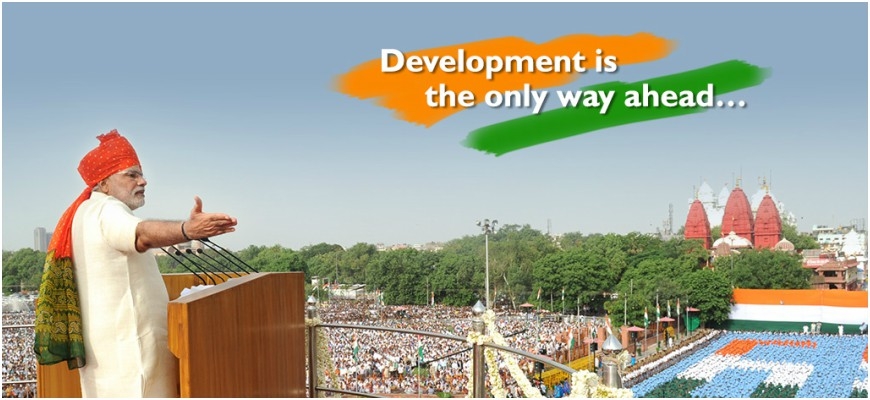Colour of Development is Saffron
Different colours have different meanings, usages in human life e.g one can have Monday morning blues (feeling sad or mildly depressed) or can go green with envy or see red when angry. Among all colour, across the world, only Saffron denotes positivity and goodness. It is the colour of energy.

Saffron symbolises all aspects of Hinduism, the oldest civilisation in the world. If development wouldn’t have been part of the Hindu civilisation it wouldn’t have survived.
Economic Historian Angus Maddison, in his book Contours of the world economy, 1–2030 CE: essays in macro-economic history, calculated, Bharat had the world's largest economy during the years 1 CE and 1000 CE. In 1000 CE according to Maddison’s calculations, China and Bharat together contributed 50.5% of world GDP (GDP being computed in 1990 dollars).
Till Saffron was the colour of governance in India it was dominating world economy along with domination in all kinds of knowledge. Bharteeya economy fell continuously under Mughal period followed by British Colonisation and then failed to take off under Nehru-Gandhi clan till 1992.
Although 1991 is considered as the celebrated turning point of Bharat’s economy due to liberalisation, in reality, the turning point was not liberalisation. The turning point was assertiveness of Hindus in 1992, which they displayed by beginning the construction of Temple for Shri Ram at Ayodhya on 6th of December. Table - 1
TABLE-1: BHARTEEYA GROWTH 1900-2000
Colonial Post-Independence Reform Period
| | 1900-1950 | 1950-1980 | 1981-1990 | 1991-2000 |
| GDP growth | 0.8 | 3.5 | 5.6 | 6.2 |
| Per capita growth | 0 | 1.3 | 3.5 | 4.4 |
Sources: 1900-1990: Angus Maddison (1995), Monitoring the World Economy, 1820-1992 (Paris:OECD); 1990-2000: World Bank/IMF.
Gurucharan Das in his essay “India: How a rich nation became poor and will be rich again”, notes: “I believe that national confidence also plays an important role. The more damaging impact of colonialism may well have been to Indian minds—it created an inferiority complex from which they have only recently recovered. Douglass North has rightly emphasized the importance of beliefs. Businessmen understand the value of confidence in entrepreneurial success and in creating a climate for investment; Historians too emphasize the power of self-belief in national success--Roman history and Britain's rise in the 19th century are examples of this.”
After Independence, it was expected that Bharat’s confidence will certainly rise, and that of common citizen it certainly did but sadly not of its leadership i.e. & Nehru-Gandhi clan. The mindset of Nehru-Gandhi clan has been best explained by Mani Shankar Iyer, one of the tallest leaders ever produced by Congress. In his book “Confessions of a Secular Fundamentalist”, he writes, “They see post-independence India as a nation free from not only 200 years of British rule but also from the previous 700 years of rule by Muslim potentates. Thus, for the proponents of Hindu nationalism, independent India is not about independence from colonial rule but liberation from the non-Hindu rule.”
Congress and Mani Shankar Ayer with Dr Manmohan Singh
For Congress and Mani Shankar Iyer, even after 1947 India was under Muslim rule and free only from British rule. No wonder, Dr Manmohan Singh the ex-Prime Minister of India said "We will have to devise innovative plans to ensure that minorities, particularly the Muslim minority, are empowered to share equitably the fruits of development. These must have the first claim on resources," while addressing the 52nd meeting of the National Development Council.
Statements of Mani Shankar Iyer and Manmohan Singh are the examples of what Gurcharan Das has written i.e. “The more damaging impact of colonialism may well have been to Indian minds—it created an inferiority complex from which they have only recently recovered”
Besides this, Dr Sarvepalli Radhakrishnan, Bharat’s 2nd President, described the significance of the saffron, represented in Bharteeya National Flag as follows: “Bhagwa or the saffron colour denotes renunciation or disinterestedness. Our leaders must be indifferent to material gains and dedicate themselves to their work.”
“Indifferent to material gains and dedicate themselves to their work”, a trait which was not there in the leaders of Nehru-Gandhi clan.
Reclaiming the Ram Janmbhoomi
With the reclaiming the Ram Janmbhoomi, the Bharateeya’s self-belief touched a new height. The national confidence was at its peak and the numbers in Table-1, substantiate the theory.
Over last few decades when the world economy has been in shambles only Bharteeya economy has shown some spine and it is directly proportional to the development of spine in Hindus.
If one looks around the world, Islamic countries have nothing to offer except terror. The Christian nations have not only succumbed to Islam but have also lost their growth under the facade of secularism and loss of colonies. The only nation which has withstood the entire onslaught of terrorism, colonialism, recession etc. is Bharat, simply due to the revival of Hinduism.
Development and Hinduism are synonymous and are represented by Saffron. The more Hindu, Bharat becomes the more developed it will be. Indisputably, “Colour of development is Saffron.”
Still, in India, there are few who have a problem with Saffron. There is a proverb in Kashmiri which defines such people. The proverb says: khar k'a: za:ni za:phra:nIc kadIr? i.e. “An ass does not know the importance of saffron”.
